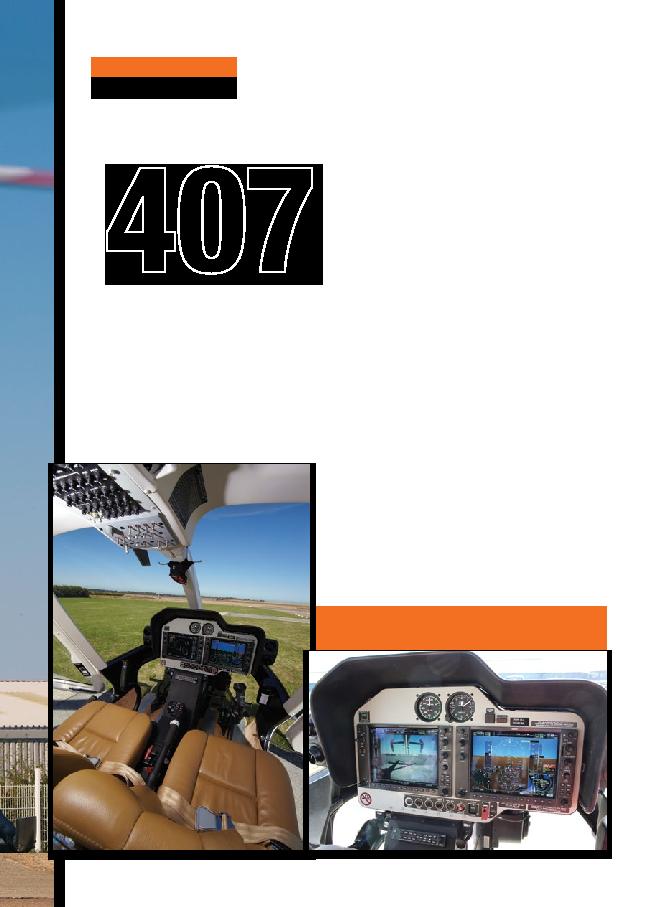
2013 JULY / Vol. 5 / No. 7 /
GA
51
T
he original 407 used the Bell
206L4 airframe but with a
carbon fibre composite tail
boom. The four-blade rotor and
hub was originally built for the
OH-58D and the blades are com-
posite without life limits. The Bell
407 is a seven seater, with captain's
seat on the right hand side.
At HeliExpo 2011, Bell
showed the new improved and
modified versions of the Bell
407GX, with the Garmin 1000
for civilian use and the Bell
407AH in military mode.
The major difference between
the Bell 407GX and the original
Bell 407 is the instrumentation.
The original 407, had an analogue
panel while the Bell 407GX has
the Garmin 1000HTM with digital
screens. The Garmin 1000 has
similar functions to the Garmin
500 so it is easy to move between
Garmins. The new Bell 407GX
has also, reportedly, been said to
be smoother than the previous
Bell 407, however, this may
also be the result of better blade
tracking in the demonstrator
model. All the 407 models do have
vibration reducers in the head.
Other differences in the
new machine are that there is a
camera on the tail and that all
the lights have been changed
to the more environmentally
friendly LED (light emitting
diode) form and these are very
clear and `clean' looking.
The tail mounted camera
pictures can be viewed on the left
hand screen of the Garmin 1000.
This, rather like modern cars,
gives a clear view of the tail rotor
and the back of the boom, useful
for reversing and for assessing
any damage that might have
been caused to the tail in flight.
It is capable of viewing up to
25 feet in complete darkness.
I flew the Bell 407GX
with Aimé Girouard, Bell
test pilot from Canada.
We started the flight with a
walk round, commencing with a
look at the rotor head. Unlike the
two-blade rotorhead of the 206
series, the Bell 407 has four blades,
which allows lower angles of
attack in flight and thus lower disc
loading. This increases the ability to
get into the `quiet mode' described
later. There are also vibration
reducers in the rotor bay to help the
smooth progress of the machine.
We move on to the engine
bay. The engine is a Rolls-
Royce 250-C47B and is FADEC
controlled. In the engine bay
there is a combined engine oil
and fuel assembly (CIFA) with
LRB (little red button) that pops
out in the event of a blockage.
The outside of the 407 is very
much the LongRanger but on this
machine there are wide pocket
`viewing windows' that improve
visibility. These have been fitted
to N-407GX, the demonstration
model both in the cockpit and in
the back, so the visibility from one
side to another is excellent and you
can imagine that if this was being
used on a tourist trip there would
no longer be any `bad' seats.
We examine the tail rotor and
see the new camera display, which
we will later view from within
the cockpit. The tail rotor has
four blades and, thanks to early
problems with the design, sits some
distance away from the tail boom.
(In the early models extravagant
movements by the pilot allowed
the tail rotor to touch the boom and
so the shaft length was extended).
However, Aimé reassures me, they
have had no further problems with
the tail rotor since its position was
407
by Georgina Hunter-Jones
Pics by Allan Norris
Helicopter Test
The Bell 407 was original conceived in 1993
as Bell's `New Light Aircraft' considered to
be a replacement for the Bell 206 series.
A Bell 206L3 was modified to provide the
pre-prototype model and was first flown
in 1994, announced at the 1995 HeliExpo.
The first prototype was flown in June 1995
and the first production model was built in
November of that year.
Garmin and Bell have worked together on the screens to reduce
pilot workload (something that is very much the catchphrase of
the moment) and improve situational awareness.
The Bell

